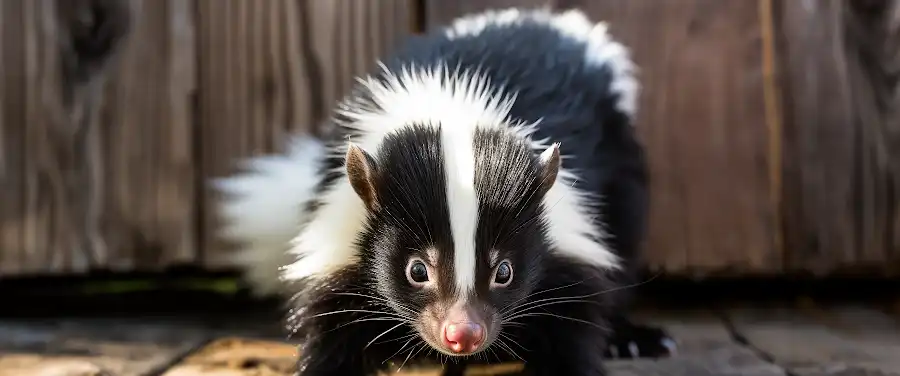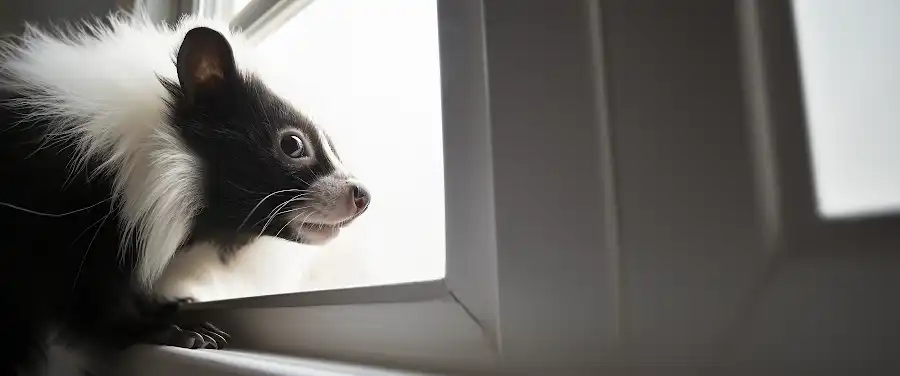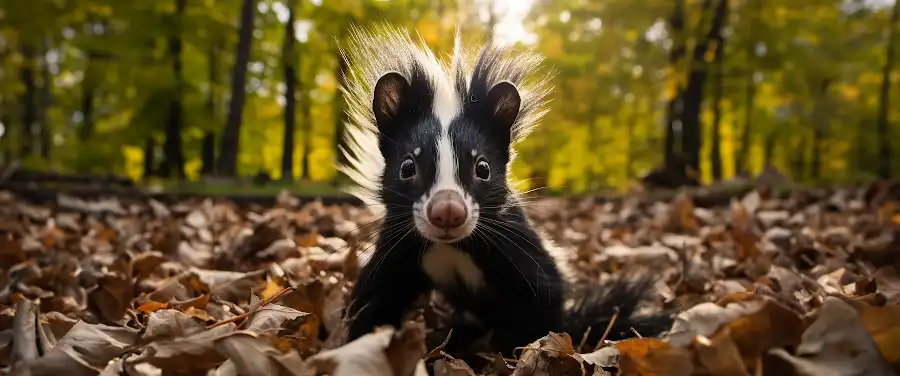
Ah, Central Florida, a place known for its palm trees, sunny beaches, and unfortunately, those pesky uninvited critters – skunks. Trust us, fam, when we say that coming across a skunk in your backyard is no pleasant experience. Not only do these animals carry a distinct, not-so-desirable perfume, but they have a knack for digging up your garden like it’s a treasure hunt. Suddenly, those blooms you were so proud of are replaced with a collection of holes. But hey, don’t sweat it too much, we’re here to help you understand the signs of a skunk infestation.
Now, you might be wondering, why should you be worried about skunks? Aren’t they just fluffy critters showing up for a visit? Well, not exactly. Let’s get something straight: skunks fit right up there in the ‘animal pests’ category, due to their tendency to wreak havoc on your property. Their habit of digging up land searching for grubs makes them quite the nuisance, especially for those who value their lawns and gardens.
Sure, Disney may depict them as cute and fuzzy, but don’t get it twisted. Beneath that adorable exterior is a penchant for destruction that could turn your home into a complete mess. A skunk infestation is more than just a furry annoyance; it’s a bona fide pest problem. Now let’s move on, together, to decipher what really sets these notorious creatures apart. After all, knowledge is power, right?
How Do Skunks Invade Homes?

Skunks are not aggressive and usually shy away from human interaction. Unfortunately, as urban development expands further into their natural habitats, a skunk invasion becomes more common. Understanding the reasons behind why skunks invade homes and the preferred skunk habitats can help to prevent or deal with a critter invasion.
Skunks search for a dwelling that provides for their major needs, such as food, water, and safety from predators. They create burrows in the ground, but if a suitable natural environment is not available, they can settle in human residences. Often drawn toward homes that offer easy access to food and waste, these black and white critters can be a pain to deal with.
What Attracts Skunks to Residential Areas?
In terms of what attracts skunks, food sources play a significant role. Skunks are omnivorous and can be attracted to a wide range of foodstuffs, including garbage, bird-feeders, fallen fruit, and pet food. This enrichment opportunity often attracts skunks and fuels a residential skunk invasion.
Another reason why these mammals may find your home appealing is the shelter it provides. Wood piles, decks, foundations, and crawl spaces are all potential shelters for skunks. Once they find these cozy spots, they become comfortable, hence attracting skunks further into your space.
Do you smell something pungent? Are you noticing small dug-out holes in your garden? These might be signs of a skunk infestation. Read on to find out more about how to identify a skunk issue.
For more information on skunks and the risks associated with an infestation, I recommend visiting this website by the CDC for a thorough understanding.
From the factors that draw skunks in, to the potential risks they pose, understanding these issues can help you recognize the Signs of a Skunk Infestation and take immediate action. Now that you are familiar with the basics, let’s move on to identify the unmistakable signs of a skunk intrusion. Stay tuned to equip yourself with valuable knowledge and effective ways to tackle this issue.
Understanding the Signs of a Skunk Infestation

Did you know that skunks are commonly found in Central Florida and are known for their unique, pungent odor and striped white-on-black fur? Well, if you start to detect an uncharacteristic smell lingering in your yard – that’s your first clue.
Arguably, the most common sign of a skunk infestation is their distinctive smell. But aside from that, these critters leave a host of residual signs that can indicate their unwelcome visit or stay. So, how can you tell you actually have a skunk infestation? Identifying the signs of a skunk infestation is key to getting a handle on a possible problem before it gets out of hand.
What are the Common Physical Signs of Skunk Presence?
Recognizing distinct physical signs can help in early identification and resolution. Check for skunk tracks, which typically have five toes and resemble the footprints of a small bear. These tracks might be noticeable in soft soil or around your garden where they search for food.
The presence of skunk dens constitutes another sign. Skunks like to burrow and can set up their dens in hollow logs, under decks or buildings, and in brush piles. A close inspection of these areas can yield signs of their presence.
Keep an eye out for droppings and digging marks by skunks. Skunk droppings are elongated and often contain undigested bits of food they’ve eaten, and their digging activity can be seen as small, cone-shaped holes in your lawn.
What Smells Indicate a Skunk Infestation?
The familiar, pungent, and unmistakable smell of a skunk infestation could be your earliest and uneasiest discovery that skunks have decided to stake a claim at your property. This is the result of skunks’ unique defensive mechanism. Upon sensing danger, skunks emit a foul odor from their anal glands. This scent not only functions as a deterrent for potential predators but also serves as a significant indication of a skunk problem for homeowners.
Are There Any Noises Associated with Skunk Infestations?
Shuffling, scratching, and whining noises during the night are a good indication of skunks, as they are known to be quite vocal when searching for food or mates. The challenging part might be identifying skunk sounds from other potential pests, such as raccoons or opossums, that can emit similar noises. Familiarize yourself with the unique sounds made by skunks, using online resources like the Internet Center for Wildlife Damage Management.
By recognizing these signs of a skunk infestation, you can set the stage for the appropriate response. Remember, the faster you identify a skunk presence, the quicker you can take action.
Stay tuned for the subsequent section where we will explore the crucial question: ” What Should You Do When You Detect a Skunk Infestation?” featuring practical, effective steps on how to handle these furry miscreants.
Conclusion
In conclusion, if you’ve noticed any of the above-mentioned signs, you might very well be dealing with a skunk infestation. Such signs may include offensive odor, damaged landscape, turned-over trashcans, and discovering skunk tracks. Skunks are not just a nuisance, but they also carry diseases that can harm your family and pets. Therefore, it’s crucial to take this issue seriously.
If you are unsure about handling the situation yourself, don’t hesitate to call for professional help. Professional pest control companies have the necessary experience and tools to ensure that these unwanted guests are removed from your property in the safest and most humane way possible. They can also give you advice on how to prevent future infestations.
Should the infestation persist, it is crucial to seek professional guidance as early as possible to avoid damage to your property and potential health risks. Remember, quick action is key in dealing with any pest infestation.
Don’t let the smelly intruders reign over your property and disrupt your peace. Guard your home, ensure the safety of your loved ones, and keep your surroundings clean and skunk-free. To recap, stay vigilant, identify the signs of a skunk infestation promptly, and don’t hesitate to seek professional help if required.
| Signs of a Skunk Infestation | Measures |
|---|---|
| Offensive Odor | Locate the source, utilize odor neutralizers |
| Damaged Landscape | Repair damages, and implement deterrents |
| Overturned Trashcans | Secure garbage cans, clean area regularly |
| Skunk Tracks | Call professionals for removal, avoid direct contact |




